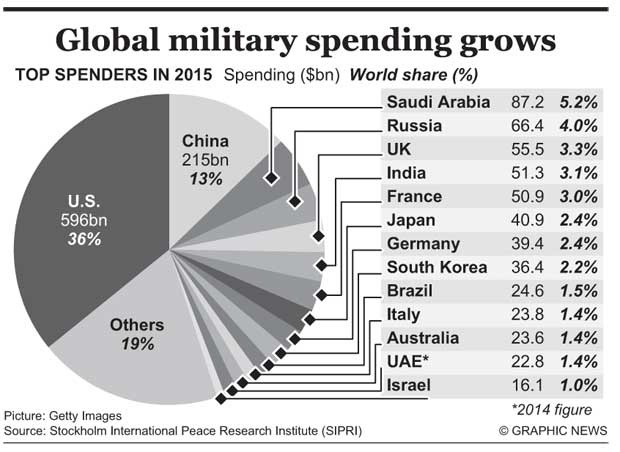19 Jun 2017 - {{hitsCtrl.values.hits}}

On June 14, the United States sealed a US $ 12 billion worth of combat aircraft deal with Qatar. This arms deal surprised many in foreign policy circles as the US President made it clear that he supported the Saudi position on Qatar given the ongoing diplomatic crises between the two nations. Yet the deal exposes deep divisions within the US administration but more importantly the increasing influence of arms sales with no real strategic direction to the Middle East. Most of these sales are emanating from American and European weapons transfers.
Thus for many progressive analysts, bombs, blockades and blunders rhyme well. Yet in  terms of global interactions when it came to arms sales, the West had engaged with many regimes in the world, irrespective of the nature of the administration from large democracies to authoritarian rulers. This article will focus more on the developments in the Middle East especially pertaining to the ongoing diplomatic rift between Saudi Arabia and Qatar with some reflections on other regions in the world given these new norms of global relations through arms sales.
terms of global interactions when it came to arms sales, the West had engaged with many regimes in the world, irrespective of the nature of the administration from large democracies to authoritarian rulers. This article will focus more on the developments in the Middle East especially pertaining to the ongoing diplomatic rift between Saudi Arabia and Qatar with some reflections on other regions in the world given these new norms of global relations through arms sales.
It may seem that we all know that the lords of war are all corporate bosses in the defence industry, yet what many would not be understanding is how deep the connection between policy makers, arms industry and global conflicts have evolved and metastasised into a cancer that seems to be going out of control. By the end of 2016, the five-year period starting from 2012 had seen the highest volume of global arms sales since the end of the cold war according to figures coming from the Stockholm International Peace Research Institute (SIPRI). Asia and Middle East accounted for the lion’s share of global arms transfers in combination accounting for nearly two thirds of all global arms transfers.
Asia’s arms procurement surge is driven by India’s relentless shopping for military hardware in the global arms market. Whilst much talk has been on in India as to how the rest of Asia is panning out is less examined. The case of Vietnam is a classic example; in 2016 Vietnam’s arm imports grew by 202% making it one of the top ten largest weapons importers in the world from its previous position of 29. The numbers are staggering when it comes to Vietnam, Russian arms sales to the Asian nation have increased by 699% over the last five years. Such effects of militarization in Asia should need more attention in a separate article In the context of Middle East some statistics may help explain the recent diplomatic crises that are gripping the region. While the American establishment was trying  to argue a case for the support of Saudi Arabia stating that Iran is a key funder of terrorism and major aggressor in the region, its arms imports were a meagre 1.12% in the region. According to SIPRI data, Saudi Arabia accounted for 7% of all global arms transfers second only to India in 2016. Arms imports to Saudi Arabia in the last five years have grown by 212% whilst in the same period Qatar’s weapons transfers increased by 245%.
to argue a case for the support of Saudi Arabia stating that Iran is a key funder of terrorism and major aggressor in the region, its arms imports were a meagre 1.12% in the region. According to SIPRI data, Saudi Arabia accounted for 7% of all global arms transfers second only to India in 2016. Arms imports to Saudi Arabia in the last five years have grown by 212% whilst in the same period Qatar’s weapons transfers increased by 245%.
Saudi Arabia’s weapons imports are driven by their deepening involvement in Yemen since 2015. It is battling a Shi’a rebel group known as the Houtis since 2015. Yemen’s war has come to scrutiny in almost all Western states where a major debate is raging whether by the support rendered to Saudis in the form of arms are being used by them to commit mass scale crimes against humanity. The Yemeni war is a classic text book case of the impact of arms in conflicts that has wider regional and global security implications.
90% of food supplies come to Yemen through the sea route and with one major access point, the port city of Hodeida currently under Houti control. Saudis are currently maintaining a massive naval blockade into the country; this has led to a humanitarian catastrophe similar to Syria. 19 million people are under the threat of an artificially induced famine. Most Yemenis have become victims of food embargoes and bombs that rain from Saudi coalition warplanes and caught in land skirmishes between Houti rebels and Saudi military coalition forces.
Whilst this humanitarian crisis is unveiling, the Americans have increased their weapons sales to Saudi Arabia, Obama administration over the last eight years had authorized arms sales over the value of US Dollars 200 billion globally and actually carried through with the sales of equipment worth $115 billion to Saudi Arabia alone. This figure is the highest in volume and value of Arms transfers carried out by an American President since the end of the Second World War
Whilst Trump boasted of US $100 billion worth of Arms sales to Saudi Arabia during his visit, experts such as Bruce Reidel, the senior fellow at Brookings with expertise on American security claimed that the amount was false and most of the deals that were discussed were pending arms sales and nothing concrete was really signed. Writing to the popular online law resource, ‘Lawfareblog.com’, he further commented that, ‘There is no $110 billion deal, instead, there are a bunch of letters of interest or intent, but not contracts’.

Yet closer investigation and research into ongoing arms sales by the United States to the middle east even in the guise of ‘defence cooperation’ does illuminate the exceptional treatment Saudi Arabia is getting with vast amounts of weapons, training and equipment. The American government agency in charge of managing defence transfers to enhance defence cooperation, known as the Defence Security Cooperation Agency (DSCA), reports that most of the recent arms transfers were to the Saudis.
The State department carried a major statement of the May 2017 arms sales agreement between Saudi Arabia and the United States in the backdrop of President Trump’s state visit. The statement claimed that the intended sales fell broadly into five categories. These categories were border security and counterterrorism, maritime and coastal security, air force modernization, air and missile defence, and cybersecurity. It also further stated by going through with this deal, ‘it demonstrates the United States’ commitment to our partnership with Saudi Arabia, while also expanding opportunities for American companies in the region, potentially supporting tens of thousands of new jobs in the United States’.
This statement is significant as it exposes the iron triangle that is gripping Washington DC and its policy makers, the unbreakable corporate connection between the congress and the arms manufactures. The promise of jobs for congressmen to win elections and in turn the congressmen lobbying for more weapons platforms and weapons sales and by doing so being the agents of global conflicts and conflict sustenance.
Arms sales to Saudi Arabia is not just an American thing, bulk of the British and French defence apparatus end up in the middle east. In 2015, the year that the Saudis started bombing Yemen, 83% of total British arms sales went to Saudi Arabia worth 900 million Sterling Pounds. UK’s arms sales have exponentially increased over the last five years to the Middle East, UAE, Qatar and Egypt were the main recipients apart from the Saudis. Thus whilst the current political and diplomatic tensions in the region are explained within diverse narratives, what is not on the surface is the impact of hardcore weapons platforms on the crises and its future implications.
The Western bloc has sustained efforts to maintain human rights regimes, humanitarian interventions and maintain liberal international institutional structures in the post World War II world. By arming and engaging in arms sales to states that have questionable rights records and being complicit about human suffering emerging from conflicts such as the case of Yemen it seems that the gravitational pull of the liberal project’s moral compass is going through an atmospheric disturbance.Thus such miscued trajectories devoid of the ethics that made the Western liberal project viable and universal in the last seventy years translates into global chaos and less global stability that is represented by the recent Saudi-Qatar dispute.

30 Oct 2024 40 minute ago
30 Oct 2024 46 minute ago
30 Oct 2024 51 minute ago
30 Oct 2024 2 hours ago
30 Oct 2024 2 hours ago